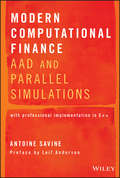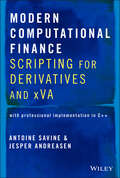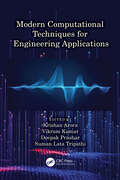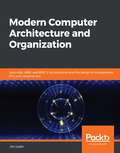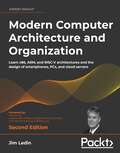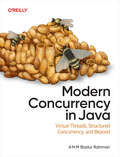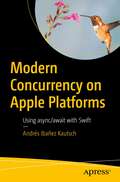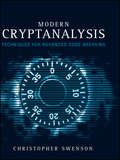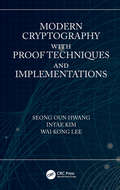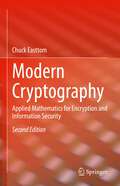- Table View
- List View
Modern Compiler Implementation in Java Second Edition
by Andrew W. Appel Jens PalsbergThis textbook describes all phases of a compiler: lexical analysis, parsing, abstract syntax, semantic actions, intermediate representations, instruction selection via tree matching, dataflow analysis, graph-coloring register allocation, and runtime systems. It includes thorough coverage of current techniques in code generation and register allocation, and the compilation of functional and object-oriented languages. The most accepted and successful techniques are described and illustrated with actual Java^TM® classes. The first part is suitable for a one-semester first course in compiler design. The second part; which includes the compilation of object-oriented and functional languages, garbage collection, loop optimization, SSA form, instruction scheduling, and optimization for cache-memory hierarchies; can be used for a second-semester or graduate course. This new edition includes more discussion of Java and object-oriented programming concepts such as visitor patterns plus a new Mini-Java programming project. A unique feature is the newly redesigned compiler project in Java for a subset of Java itself. The project includes both front-end and back-end phases.
Modern Computational Finance: AAD and Parallel Simulations
by Antoine Savine Leif AndersenArguably the strongest addition to numerical finance of the past decade, Algorithmic Adjoint Differentiation (AAD) is the technology implemented in modern financial software to produce thousands of accurate risk sensitivities, within seconds, on light hardware.AAD recently became a centerpiece of modern financial systems and a key skill for all quantitative analysts, developers, risk professionals or anyone involved with derivatives. It is increasingly taught in Masters and PhD programs in finance.Danske Bank's wide scale implementation of AAD in its production and regulatory systems won the In-House System of the Year 2015 Risk award. The Modern Computational Finance books, written by three of the very people who designed Danske Bank's systems, offer a unique insight into the modern implementation of financial models. The volumes combine financial modelling, mathematics and programming to resolve real life financial problems and produce effective derivatives software.This volume is a complete, self-contained learning reference for AAD, and its application in finance. AAD is explained in deep detail throughout chapters that gently lead readers from the theoretical foundations to the most delicate areas of an efficient implementation, such as memory management, parallel implementation and acceleration with expression templates.The book comes with professional source code in C++, including an efficient, up to date implementation of AAD and a generic parallel simulation library. Modern C++, high performance parallel programming and interfacing C++ with Excel are also covered. The book builds the code step-by-step, while the code illustrates the concepts and notions developed in the book.
Modern Computational Finance: Scripting for Derivatives and xVA
by Antoine Savine Jesper AndreasenAn incisive and essential guide to building a complete system for derivative scripting In Volume 2 of Modern Computational Finance Scripting for Derivatives and xVA, quantitative finance experts and practitioners Drs. Antoine Savine and Jesper Andreasen deliver an indispensable and insightful roadmap to the interrogation, aggregation, and manipulation of cash-flows in a variety of ways. The book demonstrates how to facilitate portfolio-wide risk assessment and regulatory calculations (like xVA). Complete with a professional scripting library written in modern C++, this stand-alone volume walks readers through the construction of a comprehensive risk and valuation tool. This essential book also offers: Effective strategies for improving scripting libraries, from basic examples—like support for dates and vectors—to advanced improvements, including American Monte Carlo techniques Exploration of the concepts of fuzzy logic and risk sensitivities, including support for smoothing and condition domains Discussion of the application of scripting to xVA, complete with a full treatment of branching Perfect for quantitative analysts, risk professionals, system developers, derivatives traders, and financial analysts, Modern Computational Finance Scripting for Derivatives and xVA: Volume 2 is also a must-read resource for students and teachers in master’s and PhD finance programs.
Modern Computational Techniques for Engineering Applications
by Vikram Kumar Suman Lata Tripathi Krishan Arora Deepak PrasharModern Computational Techniques for Engineering Applications presents recent computational techniques used in the advancement of modern grids with the integration of non-conventional energy sources like wind and solar energy. It covers data analytics tools for smart cities, smart towns, and smart computing for sustainable development.This book- Discusses the importance of renewable energy source applications wind turbines and solar panels for electrical grids. Presents optimization-based computing techniques like fuzzy logic, neural networks, and genetic algorithms that enhance the computational speed. Showcases cloud computing tools and methodologies such as cybersecurity testbeds and data security for better accuracy of data. Covers novel concepts on artificial neural networks, fuzzy systems, machine learning, and artificial intelligence techniques. Highlights application-based case studies including cloud computing, optimization methods, and the Industrial Internet of Things. The book comprehensively introduces modern computational techniques, starting from basic tools to highly advanced procedures, and their applications. It further highlights artificial neural networks, fuzzy systems, machine learning, and artificial intelligence techniques and how they form the basis for algorithms. It presents application-based case studies on cloud computing, optimization methods, blockchain technology, fog and edge computing, and the Industrial Internet of Things. It will be a valuable resource for senior undergraduates, graduate students, and academic researchers in diverse fields, including electrical engineering, electronics and communications engineering, and computer engineering.
Modern Computer Algebra
by Joachim Von Zur Gathen Jürgen GerhardComputer algebra systems are gaining more and more importance in all areas of science and engineering. This textbook gives a thorough introduction to the subject, which is the basis of the mathematical engine in computer algebra systems. It is designed to accompany one- or two-semester courses for advanced undergraduate or graduate students in computer science or mathematics. However its comprehensiveness and authority will mean it will be an essential reference also for professionals in the area. Special features include: detailed study of algorithmics including time analysis; implementation reports on several topics; complete proofs of the mathematical underpinnings; a wide variety of applications (including in chemistry, coding theory, cryptography, and the design of calendars and musical scales). Some of this material has never appeared before in book form. Finally, a great deal of historical information and illustration is included.
Modern Computer Architecture and Organization: Learn x86, ARM, and RISC-V architectures and the design of smartphones, PCs, and cloud servers
by Jim LedinA no-nonsense, practical guide to current and future processor and computer architectures, enabling you to design computer systems and develop better software applications across a variety of domains Key Features Understand digital circuitry with the help of transistors, logic gates, and sequential logic Examine the architecture and instruction sets of x86, x64, ARM, and RISC-V processors Explore the architecture of modern devices such as the iPhone X and high-performance gaming PCs Book Description Are you a software developer, systems designer, or computer architecture student looking for a methodical introduction to digital device architectures but overwhelmed by their complexity? This book will help you to learn how modern computer systems work, from the lowest level of transistor switching to the macro view of collaborating multiprocessor servers. You'll gain unique insights into the internal behavior of processors that execute the code developed in high-level languages and enable you to design more efficient and scalable software systems. The book will teach you the fundamentals of computer systems including transistors, logic gates, sequential logic, and instruction operations. You will learn details of modern processor architectures and instruction sets including x86, x64, ARM, and RISC-V. You will see how to implement a RISC-V processor in a low-cost FPGA board and how to write a quantum computing program and run it on an actual quantum computer. By the end of this book, you will have a thorough understanding of modern processor and computer architectures and the future directions these architectures are likely to take. What you will learn Get to grips with transistor technology and digital circuit principles Discover the functional elements of computer processors Understand pipelining and superscalar execution Work with floating-point data formats Understand the purpose and operation of the supervisor mode Implement a complete RISC-V processor in a low-cost FPGA Explore the techniques used in virtual machine implementation Write a quantum computing program and run it on a quantum computer Who this book is for This book is for software developers, computer engineering students, system designers, reverse engineers, and anyone looking to understand the architecture and design principles underlying modern computer systems from tiny embedded devices to warehouse-size cloud server farms. A general understanding of computer processors is helpful but not required.
Modern Computer Architecture and Organization: Learn x86, ARM, and RISC-V architectures and the design of smartphones, PCs, and cloud servers, 2nd Edition
by Jim Ledin Dave FarleyA no-nonsense, practical guide to current and future processor and computer architectures that enables you to design computer systems and develop better software applications across a variety of domainsKey FeaturesUnderstand digital circuitry through the study of transistors, logic gates, and sequential logicLearn the architecture of x86, x64, ARM, and RISC-V processors, iPhones, and high-performance gaming PCsStudy the design principles underlying the domains of cybersecurity, bitcoin, and self-driving carsBook DescriptionAre you a software developer, systems designer, or computer architecture student looking for a methodical introduction to digital device architectures, but are overwhelmed by the complexity of modern systems? This step-by-step guide will teach you how modern computer systems work with the help of practical examples and exercises. You'll gain insights into the internal behavior of processors down to the circuit level and will understand how the hardware executes code developed in high-level languages.This book will teach you the fundamentals of computer systems including transistors, logic gates, sequential logic, and instruction pipelines. You will learn details of modern processor architectures and instruction sets including x86, x64, ARM, and RISC-V. You will see how to implement a RISC-V processor in a low-cost FPGA board and write a quantum computing program and run it on an actual quantum computer.This edition has been updated to cover the architecture and design principles underlying the important domains of cybersecurity, blockchain and bitcoin mining, and self-driving vehicles.By the end of this book, you will have a thorough understanding of modern processors and computer architecture and the future directions these technologies are likely to take.What you will learnUnderstand the fundamentals of transistor technology and digital circuitsExplore the concepts underlying pipelining and superscalar processingImplement a complete RISC-V processor in a low-cost FPGAUnderstand the technology used to implement virtual machinesLearn about security-critical computing applications like financial transaction processingGet up to speed with blockchain and the hardware architectures used in bitcoin miningExplore the capabilities of self-navigating vehicle computing architecturesWrite a quantum computing program and run it on a real quantum computerWho this book is forThis book is for software developers, computer engineering students, system designers, reverse engineers, and anyone looking to understand the architecture and design principles underlying modern computer systems: ranging from tiny, embedded devices to warehouse-size cloud server farms. A general understanding of computer processors is helpful but not required.
Modern Computer Vision with PyTorch: A practical roadmap from deep learning fundamentals to advanced applications and Generative AI
by V Kishore Ayyadevara Yeshwanth ReddyThe definitive computer vision book is back, featuring the latest neural network architectures and an exploration of foundation and diffusion models Purchase of the print or Kindle book includes a free eBook in PDF formatKey FeaturesUnderstand the inner workings of various neural network architectures and their implementation, including image classification, object detection, segmentation, generative adversarial networks, transformers, and diffusion modelsBuild solutions for real-world computer vision problems using PyTorchAll the code files are available on GitHub and can be run on Google ColabBook DescriptionWhether you are a beginner or are looking to progress in your computer vision career, this book guides you through the fundamentals of neural networks (NNs) and PyTorch and how to implement state-of-the-art architectures for real-world tasks. The second edition of Modern Computer Vision with PyTorch is fully updated to explain and provide practical examples of the latest multimodal models, CLIP, and Stable Diffusion. You’ll discover best practices for working with images, tweaking hyperparameters, and moving models into production. As you progress, you'll implement various use cases for facial keypoint recognition, multi-object detection, segmentation, and human pose detection. This book provides a solid foundation in image generation as you explore different GAN architectures. You’ll leverage transformer-based architectures like ViT, TrOCR, BLIP2, and LayoutLM to perform various real-world tasks and build a diffusion model from scratch. Additionally, you’ll utilize foundation models' capabilities to perform zero-shot object detection and image segmentation. Finally, you’ll learn best practices for deploying a model to production. By the end of this deep learning book, you'll confidently leverage modern NN architectures to solve real-world computer vision problems.What you will learnGet to grips with various transformer-based architectures for computer vision, CLIP, Segment-Anything, and Stable Diffusion, and test their applications, such as in-painting and pose transferCombine CV with NLP to perform OCR, key-value extraction from document images, visual question-answering, and generative AI tasksImplement multi-object detection and segmentationLeverage foundation models to perform object detection and segmentation without any training data pointsLearn best practices for moving a model to productionWho this book is forThis book is for beginners to PyTorch and intermediate-level machine learning practitioners who want to learn computer vision techniques using deep learning and PyTorch. It's useful for those just getting started with neural networks, as it will enable readers to learn from real-world use cases accompanied by notebooks on GitHub. Basic knowledge of the Python programming language and ML is all you need to get started with this book. For more experienced computer vision scientists, this book takes you through more advanced models in the latter part of the book.
Modern Concurrency in Java: Virtual Threads, Structured Concurrency, and Beyond
by A N M Bazlur RahmanWelcome to the future of Java. With this book, you'll explore the transformative world of Java 21's key feature: virtual threads. Remember struggling with the cost of thread creation, encountering limitations on scalability, and facing difficulties in achieving high throughput? Those days are over. This practical guide takes you from Java 1.0 to the cutting-edge advancements of Project Loom. You'll learn more than just theory. Author A N M Bazlur Rahman equips you with a toolkit for taking real-world action. Take a deep dive into the intricacies of virtual threads and complex topics such as ForkJoinPool, continuation, rate limiting, debugging, and monitoring. You'll not only learn how they work, but you'll also pick up expert tips and tricks to help you master these concepts. And you'll learn about structured concurrency and scoped values—critical skills for building Java applications that are scalable and efficient. Get an in-depth understanding of virtual threads Understand the implementation of virtual thread internals Gain performance improvement in blocking operations Learn why structured concurrency is beneficial Know where to use scoped value Understand the relevance of reactive Java with the advent of virtual threads A N M Bazlur Rahman is a software engineer with over a decade of experience in Java and related technologies. A speaker at various international conferences and Java user groups, his talks often focus on specialized topics such as concurrency and virtual threads.
Modern Concurrency on Apple Platforms: Using async/await with Swift
by Andrés Ibañez KautschBuild solid software with modern and safe concurrency features. Concurrency is one of the hardest problems in computer science. For years, computer scientists and engineers have developed different strategies for dealing with concurrency. However, the original concurrency primitives are complicated and difficult to understand, and even harder to implement. Using the new async/await APIs in Swift, this book will explain how your code can abstract a lot of the complexity with a simpler interface so you never have to deal with concurrency primitives such as semaphores, locks, and threads yourself. This will allow you to write concurrent code that is easier to read, easier to write, and easier to maintain. These new APIs are deeply ingrained into Swift, offering compile-level features that will keep you from writing dangerous concurrent code. You’ll start by exploring why concurrency is hard to implement in a traditional system. Explaining the definition of concurrency and what its primitives are will help you understand why they are hard to use correctly. These concepts will become clearer as you work through the sample projects. The book’s focus then shifts exclusively to the new APIs, helping you understand how the integration of the system with the language itself makes it easier for you to write concurrent code without overstepping the bounds of the concurrency safe zone. By the end of the book, you’ll have a solid foundation for working safely with concurrent code using the new async/await APIs.What You'll LearnUnderstand concurrency and its traditional problems Work with the new async/await API and all its features, from the basic usage and await keywords, to task groups and async sequences.Implement modern and safe concurrent code that you can start using right awayWho This Book Is For Experienced iOS developers at a semi-senior or senior level. Knowledge on the Grand Central Dispatch is a bonus, but not required.
Modern Cryptanalysis
by Christopher SwensonAs an instructor at the University of Tulsa, Christopher Swenson could find no relevant text for teaching modern cryptanalysis?so he wrote his own. This is the first book that brings the study of cryptanalysis into the 21st century. Swenson provides a foundation in traditional cryptanalysis, examines ciphers based on number theory, explores block ciphers, and teaches the basis of all modern cryptanalysis: linear and differential cryptanalysis. This time-honored weapon of warfare has become a key piece of artillery in the battle for information security.
Modern Cryptography for Cybersecurity Professionals: Learn how you can use encryption to better secure your organization's data
by Lisa BockAs a Cybersecurity Professional, discover how to implement cryptographic techniques to help your organization mitigate the risks of altered, disclosed, or stolen dataKey FeaturesDiscover how cryptography is used to secure data in motion as well as at restCompare symmetric with asymmetric encryption and learn how a hash is usedGet to grips with different types of cryptographic solutions along with common applicationsBook DescriptionIn today's world, it is important to have confidence in your data storage and transmission strategy. Cryptography can provide you with confidentiality, integrity, authentication, and non-repudiation. But are you aware of just what exactly is involved in using cryptographic techniques? Modern Cryptography for Cybersecurity Professionals helps you to gain a better understanding of the cryptographic elements necessary to secure your data. The book begins by helping you to understand why we need to secure data and how encryption can provide protection, whether it be in motion or at rest. Then, you'll delve into symmetric and asymmetric encryption and discover how a hash is used. As you advance, you'll see how the public key infrastructure (PKI) and certificates build trust between parties, so that we can confidently encrypt and exchange data. Finally, you'll explore the practical applications of cryptographic techniques, including passwords, email, and blockchain technology, along with securely transmitting data using a virtual private network (VPN). By the end of this cryptography book, you'll have gained a solid understanding of cryptographic techniques and terms, learned how symmetric and asymmetric encryption along with how a hash is used, and recognized the importance of key management and the PKI.What you will learnLearn how network attacks can compromise dataReview practical uses of cryptography over timeCompare how symmetric and asymmetric encryption workExplore how a hash can ensure data integrity and authenticationUnderstand the laws that govern the need to secure dataDiscover the practical applications of cryptographic techniquesFind out how the PKI enables trustGet to grips with how data can be secured using a VPNWho this book is forThis book is for IT managers, security professionals, students, teachers, and anyone looking to learn more about cryptography and understand why it is important in an organization as part of an overall security framework. A basic understanding of encryption and general networking terms and concepts is needed to get the most out of this book.
Modern Cryptography with Proof Techniques and Implementations
by Seong Oun Hwang Intae Kim Wai Kong LeeProof techniques in cryptography are very difficult to understand, even for students or researchers who major in cryptography. In addition, in contrast to the excessive emphases on the security proofs of the cryptographic schemes, practical aspects of them have received comparatively less attention. This book addresses these two issues by providing detailed, structured proofs and demonstrating examples, applications and implementations of the schemes, so that students and practitioners may obtain a practical view of the schemes. Seong Oun Hwang is a professor in the Department of Computer Engineering and director of Artificial Intelligence Security Research Center, Gachon University, Korea. He received the Ph.D. degree in computer science from the Korea Advanced Institute of Science and Technology (KAIST), Korea. His research interests include cryptography, cybersecurity, networks, and machine learning. Intae Kim is an associate research fellow at the Institute of Cybersecurity and Cryptology, University of Wollongong, Australia. He received the Ph.D. degree in electronics and computer engineering from Hongik University, Korea. His research interests include cryptography, cybersecurity, and networks. Wai Kong Lee is an assistant professor in UTAR (University Tunku Abdul Rahman), Malaysia. He received the Ph.D. degree in engineering from UTAR, Malaysia. In between 2009 – 2012, he served as an R&D engineer in several multinational companies including Agilent Technologies (now known as Keysight) in Malaysia. His research interests include cryptography engineering, GPU computing, numerical algorithms, Internet of Things (IoT) and energy harvesting.
Modern Cryptography: Applied Mathematics for Encryption and Information Security
by William EasttomThis textbook is a practical yet in depth guide to cryptography and its principles and practices. The book places cryptography in real-world security situations using the hands-on information contained throughout the chapters. Prolific author Dr. Chuck Easttom lays out essential math skills and fully explains how to implement cryptographic algorithms in today's data protection landscape. Readers learn and test out how to use ciphers and hashes, generate random keys, handle VPN and Wi-Fi security, and encrypt VoIP, Email, and Web communications. The book also covers cryptanalysis, steganography, and cryptographic backdoors and includes a description of quantum computing and its impact on cryptography. This book is meant for those without a strong mathematics background _ only just enough math to understand the algorithms given. The book contains a slide presentation, questions and answers, and exercises throughout. Presents a comprehensive coverage of cryptography in an approachable format;Covers the basic math needed for cryptography _ number theory, discrete math, and algebra (abstract and linear);Includes a full suite of classroom materials including exercises, Q&A, and examples.
Modern Cryptography: Applied Mathematics for Encryption and Information Security
by William EasttomThis expanded textbook, now in its second edition, is a practical yet in depth guide to cryptography and its principles and practices. Now featuring a new section on quantum resistant cryptography in addition to expanded and revised content throughout, the book continues to place cryptography in real-world security situations using the hands-on information contained throughout the chapters. Prolific author Dr. Chuck Easttom lays out essential math skills and fully explains how to implement cryptographic algorithms in today's data protection landscape. Readers learn and test out how to use ciphers and hashes, generate random keys, handle VPN and Wi-Fi security, and encrypt VoIP, Email, and Web communications. The book also covers cryptanalysis, steganography, and cryptographic backdoors and includes a description of quantum computing and its impact on cryptography. This book is meant for those without a strong mathematics background with only just enough math to understand the algorithms given. The book contains a slide presentation, questions and answers, and exercises throughout.Presents new and updated coverage of cryptography including new content on quantum resistant cryptography;Covers the basic math needed for cryptography - number theory, discrete math, and algebra (abstract and linear);Includes a full suite of classroom materials including exercises, Q&A, and examples.
Modern Data Access with Entity Framework Core: Database Programming Techniques for .NET, .NET Core, UWP, and Xamarin with C#
by Holger SchwichtenbergC# developers, here’s your opportunity to learn the ins-and-outs of Entity Framework Core, Microsoft’s recently redesigned object-relational mapper. Benefit from hands-on learning that will teach you how to tackle frustrating database challenges, such as workarounds to missing features in Entity Framework Core, and learn how to optimize the performance of your applications, head-on!Modern Data Access with Entity Framework Core teaches best practices, guidance, and shortcuts that will significantly reduce the amount of resources you internally dedicate to programming data access code. The proven methods and tools taught in this book, such as how to get better performance, and the ability to select the platform of your choice, will save you valuable time and allow you to create seamless data access. Dive into succinct guidance that covers the gamut-- from installing Entity Framework Core, reverse engineering, forward engineering (including schema migrations), and data reading and modification with LINQ, Dynamic LINQ, SQL, Stored Procedures, and Table Valued Functions- to using third-party products such as LINQPad, Entity Developer, Entity Framework Profiler, EFPlus, and AutoMapper. You'll also appreciate excerpts of conceptual software architecture discussion around Entity Framework Core that might otherwise take years to learn.What You'll LearnUnderstand the core concepts of Entity Framework Core, as well process models for existing databases (reverse engineering) and the generation of database schemas from object models (forward engineering)Study real-world case studies for hands-on EF Core instructionGet up to speed with valuable database access scenarios and code samplesDiscover workarounds to augment missing features in Entity Framework CoreUse Entity Framework Core to write mobile appsBonus online appendix covers Entity Framework Core 2.1 release updatesWho This Book Is ForSoftware developers who have basic experience with .NET and C#, as well as some understanding of relational databases. Knowledge of predecessor technologies such as ADO.NET and the classic ADO.NET Entity Framework is not necessary to learn from this book.
Modern Data Analytics in Excel: Using Power Query, Power Pivot, and More for Enhanced Data Analytics
by George MountIf you haven't modernized your data cleaning and reporting processes in Microsoft Excel, you're missing out on big productivity gains. And if you're looking to conduct rigorous data analysis, more can be done in Excel than you think. This practical book serves as an introduction to the modern Excel suite of features along with other powerful tools for analytics.George Mount of Stringfest Analytics shows business analysts, data analysts, and business intelligence specialists how to make bigger gains right from your spreadsheets by using Excel's latest features. You'll learn how to build repeatable data cleaning workflows with Power Query, and design relational data models straight from your workbook with Power Pivot. You'll also explore other exciting new features for analytics, such as dynamic array functions, AI-powered insights, and Python integration.Learn how to build reports and analyses that were previously difficult or impossible to do in Excel. This book shows you how to:Build repeatable data cleaning processes for Excel with Power QueryCreate relational data models and analysis measures with Power PivotPull data quickly with dynamic arraysUse AI to uncover patterns and trends from inside ExcelIntegrate Python functionality with Excel for automated analysis and reporting
Modern Data Architecture on Azure: Design Data-centric Solutions on Microsoft Azure
by Sagar LadThis book is an exhaustive guide to designing and implementing data solutions on Azure. It covers the process of managing data from end to end, starting from data collection all the way through transformation, distribution, and consumption. Modern Data Architecture on Azure begins with an introduction to the fundaments of data management, followed by a demonstration of how to build relational and non-relational data solutions on Azure. Here, you will learn data processing for complex analysis and how to work with CSV and JSON files. Moving forward, you will learn the foundational concepts of big data architecture, along with data management patterns and technology options offered by Azure. From there, you’ll be walked through the data architecture process, including data consortium on Azure, enterprise data governance, and much more. The book culminates with a deep dive into data architecture frameworks with data modeling. After reading this book, you will have a thorough understanding of data design and analytics using Azure, allowing you to collect and analyze massive amounts of data to optimize business performance, forecast future results, and more. What Will You Learn Understand the fundamentals of data architecture including data management, data handling ethics, data governance, and metadata managementAnalyze and understand business needs to choose the right Azure services and make informed business decisionsUnderstand Azure Cloud Data design patterns for relational and non-relational data, batch real-time processing, and ETL/ELT pipelinesModernize data architecture using Azure to leverage data and AI to enable digital transformation by securing and optimizing overall data lifecycle management Who Is This Book For: Data solution architects, data engineers, and IT consultants who want to gain a better understanding of modern data architecture design and implementation on Azure.
Modern Data Engineering with Apache Spark: A Hands-On Guide for Building Mission-Critical Streaming Applications
by Scott HainesLeverage Apache Spark within a modern data engineering ecosystem. This hands-on guide will teach you how to write fully functional applications, follow industry best practices, and learn the rationale behind these decisions. With Apache Spark as the foundation, you will follow a step-by-step journey beginning with the basics of data ingestion, processing, and transformation, and ending up with an entire local data platform running Apache Spark, Apache Zeppelin, Apache Kafka, Redis, MySQL, Minio (S3), and Apache Airflow.Apache Spark applications solve a wide range of data problems from traditional data loading and processing to rich SQL-based analysis as well as complex machine learning workloads and even near real-time processing of streaming data. Spark fits well as a central foundation for any data engineering workload. This book will teach you to write interactive Spark applications using Apache Zeppelin notebooks, write and compile reusable applications and modules, and fully test both batch and streaming. You will also learn to containerize your applications using Docker and run and deploy your Spark applications using a variety of tools such as Apache Airflow, Docker and Kubernetes.Reading this book will empower you to take advantage of Apache Spark to optimize your data pipelines and teach you to craft modular and testable Spark applications. You will create and deploy mission-critical streaming spark applications in a low-stress environment that paves the way for your own path to production. What You Will LearnSimplify data transformation with Spark Pipelines and Spark SQLBridge data engineering with machine learningArchitect modular data pipeline applications Build reusable application components and libraries Containerize your Spark applications for consistency and reliabilityUse Docker and Kubernetes to deploy your Spark applicationsSpeed up application experimentation using Apache Zeppelin and Docker Understand serializable structured data and data contracts Harness effective strategies for optimizing data in your data lakes Build end-to-end Spark structured streaming applications using Redis and Apache Kafka Embrace testing for your batch and streaming applications Deploy and monitor your Spark applications Who This Book Is ForProfessional software engineers who want to take their current skills and apply them to new and exciting opportunities within the data ecosystem, practicing data engineers who are looking for a guiding light while traversing the many challenges of moving from batch to streaming modes, data architects who wish to provide clear and concise direction for how best to harness and use Apache Spark within their organization, and those interested in the ins and outs of becoming a modern data engineer in today's fast-paced and data-hungry world
Modern Data Mining Algorithms in C++ and CUDA C: Recent Developments in Feature Extraction and Selection Algorithms for Data Science
by Timothy MastersDiscover a variety of data-mining algorithms that are useful for selecting small sets of important features from among unwieldy masses of candidates, or extracting useful features from measured variables. As a serious data miner you will often be faced with thousands of candidate features for your prediction or classification application, with most of the features being of little or no value. You’ll know that many of these features may be useful only in combination with certain other features while being practically worthless alone or in combination with most others. Some features may have enormous predictive power, but only within a small, specialized area of the feature space. The problems that plague modern data miners are endless. This book helps you solve this problem by presenting modern feature selection techniques and the code to implement them. Some of these techniques are:Forward selection component analysis Local feature selection Linking features and a target with a hidden Markov model Improvements on traditional stepwise selection Nominal-to-ordinal conversion All algorithms are intuitively justified and supported by the relevant equations and explanatory material. The author also presents and explains complete, highly commented source code. The example code is in C++ and CUDA C but Python or other code can be substituted; the algorithm is important, not the code that's used to write it. What You Will Learn Combine principal component analysis with forward and backward stepwise selection to identify a compact subset of a large collection of variables that captures the maximum possible variation within the entire set. Identify features that may have predictive power over only a small subset of the feature domain. Such features can be profitably used by modern predictive models but may be missed by other feature selection methods. Find an underlying hidden Markov model that controls the distributions of feature variables and the target simultaneously. The memory inherent in this method is especially valuable in high-noise applications such as prediction of financial markets. Improve traditional stepwise selection in three ways: examine a collection of 'best-so-far' feature sets; test candidate features for inclusion with cross validation to automatically and effectively limit model complexity; and at each step estimate the probability that our results so far could be just the product of random good luck. We also estimate the probability that the improvement obtained by adding a new variable could have been just good luck. Take a potentially valuable nominal variable (a category or class membership) that is unsuitable for input to a prediction model, and assign to each category a sensible numeric value that can be used as a model input. Who This Book Is For Intermediate to advanced data science programmers and analysts. C++ and CUDA C experience is highly recommended. However, this book can be used as a framework using other languages such as Python.
Modern Data Protection: Ensuring Recoverability Of All Modern Workloads
by W. Curtis PrestonGive your organization the data protection it deserves without the uncertainty and cost overruns experienced by your predecessors or other companies. System and network administrators have their work cut out for them to protect physical and virtual machines in the data center and the cloud; mobile devices including laptops and tablets; SaaS services like Microsoft 365, Google Workspace, and Salesforce; and persistent data created by Kubernetes and container workloads.To help you navigate the breadth and depth of this challenge, this book presents several solutions so you can determine which is right for your company. You'll learn the unique requirements that each workload presents, then explore various categories of commercial backup hardware, software, and services available to protect these data sources, including the advantages and disadvantages of each approach.Learn the workload types that your organization should be backing upExplore the hardware, software, and services you can use to back up your systemsUnderstand what's wrong with your current data protection systemPair your backed-up workloads to the appropriate backup systemLearn the adjustments that will make your backups better, without wasting money
Modern Data Science with R (Chapman & Hall/CRC Texts in Statistical Science)
by Benjamin S. Baumer Daniel T. Kaplan Nicholas J. HortonModern Data Science with R is a comprehensive data science textbook for undergraduates that incorporates statistical and computational thinking to solve real-world problems with data. Rather than focus exclusively on case studies or programming syntax, this book illustrates how statistical programming in the state-of-the-art R/RStudio computing environment can be leveraged to extract meaningful information from a variety of data in the service of addressing compelling statistical questions. <P><P> Contemporary data science requires a tight integration of knowledge from statistics, computer science, mathematics, and a domain of application. This book will help readers with some background in statistics and modest prior experience with coding develop and practice the appropriate skills to tackle complex data science projects. The book features a number of exercises and has a flexible organization conducive to teaching a variety of semester courses.
Modern Data Science with R (Chapman & Hall/CRC Texts in Statistical Science)
by Benjamin S. Baumer Daniel T. Kaplan Nicholas J. HortonFrom a review of the first edition: "Modern Data Science with R… is rich with examples and is guided by a strong narrative voice. What’s more, it presents an organizing framework that makes a convincing argument that data science is a course distinct from applied statistics" (The American Statistician).Modern Data Science with R is a comprehensive data science textbook for undergraduates that incorporates statistical and computational thinking to solve real-world data problems. Rather than focus exclusively on case studies or programming syntax, this book illustrates how statistical programming in the state-of-the-art R/RStudio computing environment can be leveraged to extract meaningful information from a variety of data in the service of addressing compelling questions.The second edition is updated to reflect the growing influence of the tidyverse set of packages. All code in the book has been revised and styled to be more readable and easier to understand. New functionality from packages like sf, purrr, tidymodels, and tidytext is now integrated into the text. All chapters have been revised, and several have been split, re-organized, or re-imagined to meet the shifting landscape of best practice.
Modern Data Strategy
by Mike Fleckenstein Lorraine FellowsThis book contains practical steps business users can take to implement data management in a number of ways, including data governance, data architecture, master data management, business intelligence, and others. It defines data strategy, and covers chapters that illustrate how to align a data strategy with the business strategy, a discussion on valuing data as an asset, the evolution of data management, and who should oversee a data strategy. This provides the user with a good understanding of what a data strategy is and its limits. Critical to a data strategy is the incorporation of one or more data management domains. Chapters on key data management domains—data governance, data architecture, master data management and analytics, offer the user a practical approach to data management execution within a data strategy. The intent is to enable the user to identify how execution on one or more data management domains can help solve business issues. This book is intended for business users who work with data, who need to manage one or more aspects of the organization’s data, and who want to foster an integrated approach for how enterprise data is managed. This book is also an excellent reference for students studying computer science and business management or simply for someone who has been tasked with starting or improving existing data management.
Modern Data Visualization with R (Chapman & Hall/CRC The R Series)
by Robert KabacoffModern Data Visualization with R describes the many ways that raw and summary data can be turned into visualizations that convey meaningful insights. It starts with basic graphs such as bar charts, scatter plots, and line charts, but progresses to less well-known visualizations such as tree maps, alluvial plots, radar charts, mosaic plots, effects plots, correlation plots, biplots, and the mapping of geographic data. Both static and interactive graphics are described and the use of color, shape, shading, grouping, annotation, and animations are covered in detail. The book moves from a default look and feel for graphs, to graphs with customized colors, fonts, legends, annotations, and organizational themes.Features Contains a wide breadth of graph types including newer and less well-known approaches Connects each graph type to the characteristics of the data and the goals of the analysis Moves the reader from simple graphs describing one variable to building visualizations that describe complex relationships among many variables Provides newer approaches to creating interactive web graphics via JavaScript libraries Details how to customize each graph type to meet users’ needs and those of their audiences Gives methods for creating visualizations that are publication ready for print (in color or black and white) and the web Suggests best practices Offers examples from a wide variety of fields The book is written for those new to data analysis as well as the seasoned data scientist. It can be used for both teaching and research, and will particularly appeal to anyone who needs to describe data visually and wants to find and emulate the most appropriate method quickly. The reader should have some basic coding experience, but expertise in R is not required. Some of the later chapters (e.g., visualizing statistical models) assume exposure to statistical inference at the level of analysis of variance and regression.

